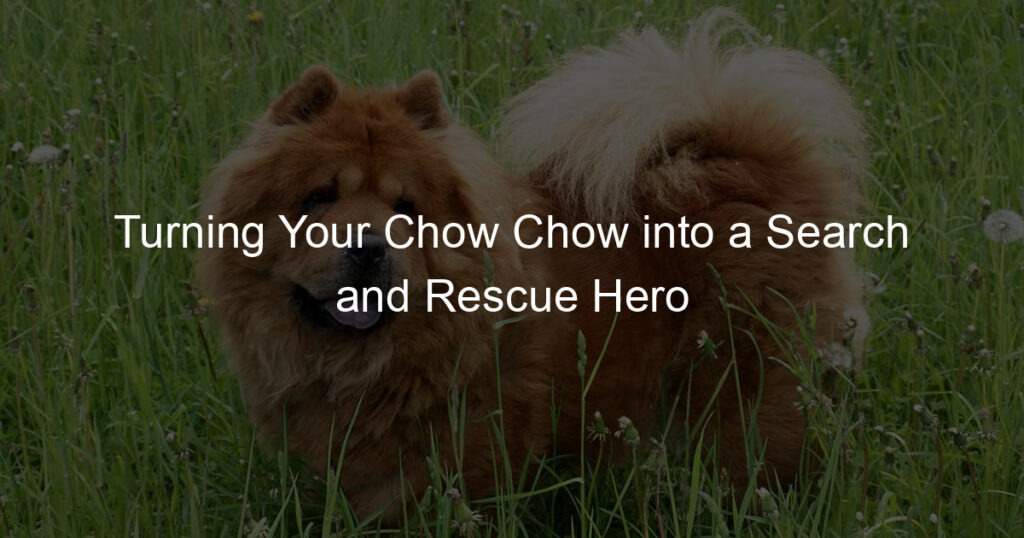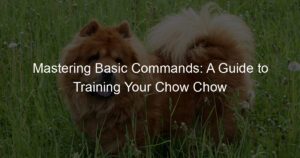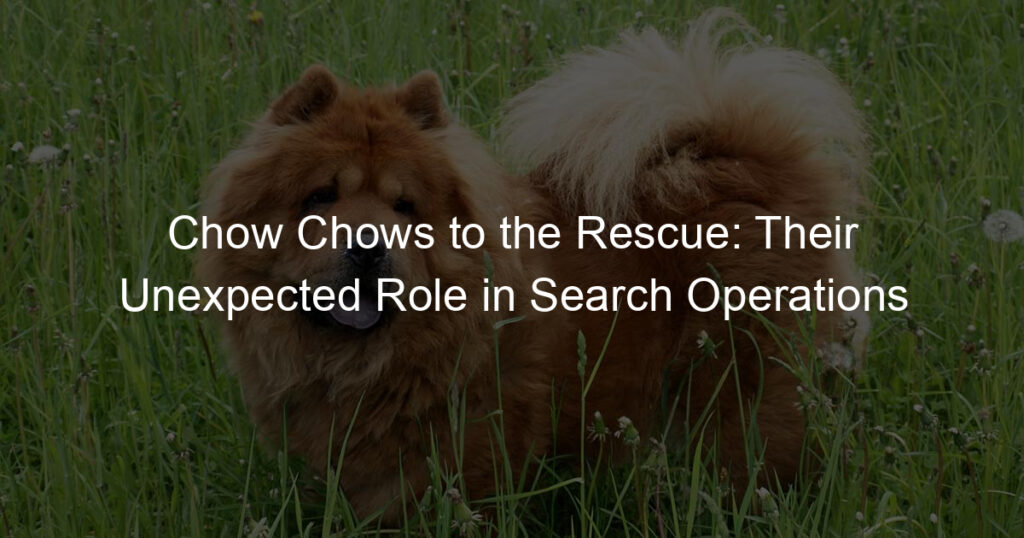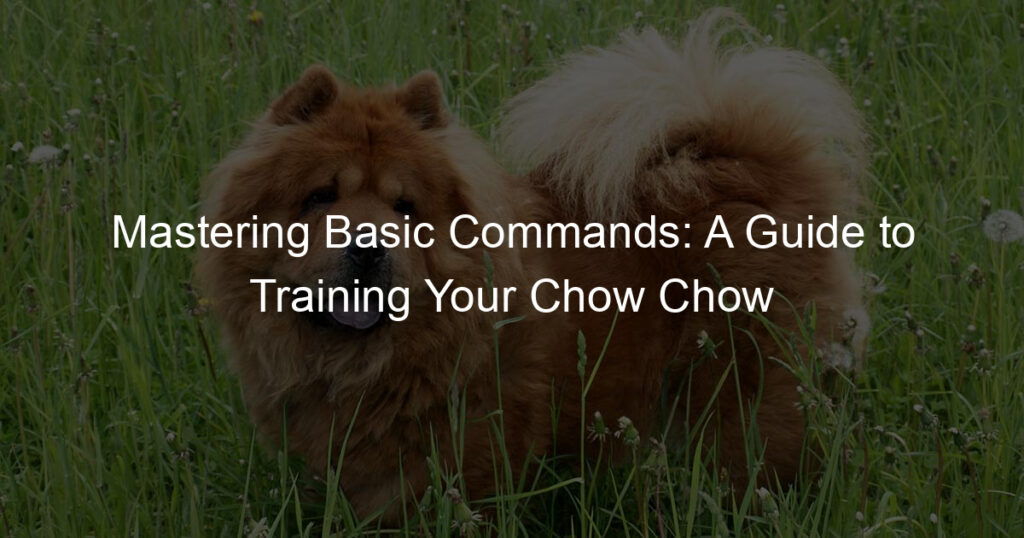
Introduction to Chow Chow Training for Search and Rescue
When we think of Search and Rescue dogs, breeds like the German Shepherd or the Labrador Retriever might come to mind. However, the Chow Chow, a breed known for its lion-like appearance and unique blue-black tongue, can also make an excellent Search and Rescue dog with the right training. In this article, we will explore the role of a Search and Rescue dog and why Chow Chows are suitable for this important job.
Search and Rescue dogs play a crucial role in locating missing persons in various environments, from dense forests to disaster-stricken areas. These dogs are trained to use their powerful sense of smell to find people who are lost or in danger. They work closely with their handlers, who guide them during searches and interpret their signals when they locate someone. Search and Rescue dogs are not only heroes but also invaluable members of rescue teams around the world.
Chow Chows are known for their keen sense of smell, which is a vital trait for a Search and Rescue dog. They are also intelligent and can be trained to follow commands accurately. Chow Chows are sturdy and can endure challenging terrains and weather conditions, making them suitable for search and rescue missions. Their thick double coat protects them in cold weather, while their strong build allows them to navigate rough terrains. Moreover, Chow Chows are loyal and protective, qualities that are essential for a Search and Rescue dog. With proper training, a Chow Chow can become a reliable partner in search and rescue missions.
Preparing Your Chow Chow for Search and Rescue Training
Before embarking on search and rescue training with your Chow Chow, it’s crucial to ensure they are physically prepared. This involves two key steps: ensuring your dog is in good health and maintaining a regular exercise and diet routine.
Physical Preparation
- Ensuring your Chow Chow is in good health
Before starting any training, it’s essential to ensure your Chow Chow is in good health. Regular vet check-ups are a must. Your vet can assess your dog’s overall health and make sure they are fit for the physical demands of search and rescue training. This includes checking their heart health, joint flexibility, and overall stamina. Remember, a healthy dog is a happy and productive dog.
- Regular exercise and diet for a Chow Chow
Exercise and diet play a crucial role in your Chow Chow’s physical preparation. Regular exercise helps build your dog’s stamina and strength, both of which are essential for search and rescue tasks. Try to incorporate a mix of activities in your dog’s routine, such as walking, running, and playing fetch.
When it comes to diet, your Chow Chow needs a balanced and nutritious meal. High-quality dog food rich in protein helps build muscle, while carbohydrates provide the energy they need for their training. Always ensure they have access to fresh water, especially after exercise.
| Key Physical Preparation Tips for Chow Chows |
|---|
| Regular vet check-ups to ensure good health |
| Maintain a regular exercise routine |
| Provide a balanced and nutritious diet |
Remember, physical preparation is just as important as the training itself. By ensuring your Chow Chow is healthy and well-exercised, you’re setting them up for success in their search and rescue training.
Mental Preparation
Before we dive into the specifics of training your Chow Chow for search and rescue, it’s crucial to understand the importance of mental preparation. This involves building a strong bond with your dog and teaching them basic commands. Let’s explore these two critical aspects.
- Developing a strong bond with your Chow Chow
Building a strong bond with your Chow Chow is the foundation of any successful training. This bond fosters trust, respect, and mutual understanding, which are all vital for effective search and rescue training.
Start by spending quality time with your Chow Chow. This could involve playing games, going for walks, or simply sitting together. Remember, the goal is to create a deep connection and trust between you and your dog.
Try to understand your Chow Chow’s behavior and respond appropriately. For instance, if your dog seems anxious or scared, it’s essential to comfort them and assure them of their safety. This will help your dog to trust you more and be more receptive to training.
- Teaching basic commands to your Chow Chow
Once you’ve established a strong bond with your Chow Chow, the next step is to teach them basic commands. These commands form the basis of search and rescue training and are crucial for your dog’s safety and effectiveness.
Start with simple commands like ‘sit’, ‘stay’, ‘come’, and ‘leave it’. Remember to be patient and consistent in your training. Reward your Chow Chow for correctly following commands to encourage them to repeat the behavior.
As your Chow Chow masters these basic commands, you can gradually introduce more complex commands that are specific to search and rescue training. For example, you could teach your dog to ‘search’ or ‘find’.
Remember, mental preparation is just as important as physical preparation in search and rescue training. By developing a strong bond with your Chow Chow and teaching them basic commands, you’re setting the stage for successful training and potentially life-saving work.
Training Techniques for Chow Chows
Training a Chow Chow can be a rewarding experience. One of the most effective methods to train these intelligent dogs is through positive reinforcement. This technique focuses on rewarding good behavior, which encourages your Chow Chow to repeat it.
Positive Reinforcement
Positive reinforcement is a method that uses rewards to encourage good behavior. This can be done using treats, praises, or a combination of both. Let’s delve into how you can use these techniques effectively.
-
- How to use treats and praises effectively
When your Chow Chow performs a desired behavior, immediately reward them with a treat or praise. This will help them associate the behavior with the reward. Remember, timing is crucial. The reward should be given immediately after the behavior is performed. Also, vary the treats and praises to keep your Chow Chow interested and motivated.
-
- Training a Chow Chow using clicker training
Clicker training is another form of positive reinforcement. A clicker is a small device that makes a distinct sound. When your Chow Chow performs a desired behavior, immediately click the device and give them a treat. This helps your dog associate the sound with the reward, and over time, they will understand that the sound means they’ve done something right. This method is effective because it allows you to mark the exact moment your Chow Chow performs the desired behavior, making it easier for them to understand what they’re being rewarded for.
Remember, patience and consistency are key when training your Chow Chow. It might take some time, but with positive reinforcement, your Chow Chow will soon start to understand and repeat the desired behaviors. Happy training!
Consistency and Repetition
When it comes to training your Chow Chow for search and rescue missions, two key elements play a pivotal role: consistency and repetition. Let’s delve into these aspects.
-
- Importance of Consistent Commands and Routines
Consistency is the cornerstone of effective Chow Chow training. It’s essential to use the same commands and maintain consistent routines. This helps your Chow Chow understand what is expected of them, and it also fosters a sense of security and trust. For instance, if you use the command “sit” one day and “down” the next to instruct your Chow Chow to sit, it could lead to confusion. Consistency in commands helps your dog associate specific actions with certain words, making training more effective.
-
- Role of Repetition in Chow Chow Training
Repetition is another crucial aspect of training your Chow Chow. Repetition helps reinforce learning and ingrains the desired behaviors into your dog’s memory. The more your Chow Chow practices a command or routine, the better they get at it. For instance, if you’re teaching your Chow Chow to find a scent, repeating the exercise multiple times will help them understand and remember the task. Remember, practice makes perfect!
In conclusion, consistency and repetition are key to successful Chow Chow training. By maintaining consistent commands and routines, and repeating them regularly, you can effectively train your Chow Chow for search and rescue missions.
Chow Chow Search and Rescue Training
In the world of search and rescue, Chow Chows can play a vital role. With their keen sense of smell and adaptable nature, these dogs are well-suited for this demanding work. Let’s delve into the specifics of training a Chow Chow for search missions.
Training a Chow Chow for Search
Training a Chow Chow for search involves two main areas: scent detection and working in different environments. Both of these areas require specific training techniques.
-
- Training techniques for scent detection
Scent detection is a critical skill for search and rescue dogs. Training a Chow Chow in scent detection involves teaching them to identify and locate specific scents. This is usually done using a combination of rewards and repetition. For example, a trainer might start by associating a specific scent with a treat. Over time, the Chow Chow learns to associate that scent with a reward, encouraging them to seek it out.
-
- Training a Chow Chow to work in different environments
Search and rescue missions can take place in a variety of environments, from dense forests to urban areas. It’s important that a Chow Chow is comfortable and capable in all of these settings. Training can involve exposing the dog to different types of terrain and weather conditions, as well as teaching them to navigate obstacles. This helps to build their confidence and adaptability, making them more effective in their search and rescue work.
Training a Chow Chow for search and rescue is a challenging but rewarding task. With the right training and dedication, these dogs can become invaluable members of any search and rescue team.
Training a Chow Chow for Rescue
Training a Chow Chow for rescue operations is a rewarding task that requires patience, consistency, and a deep understanding of this unique breed. Let’s delve into the key steps involved in this process.
- Teaching a Chow Chow to Alert Handlers
Training a Chow Chow to alert handlers is the first step in rescue training. This involves teaching the dog to bark, whine, or make other noticeable signals when they find what they’re searching for.
Start with simple commands like “sit” and “stay”, gradually introducing more complex commands like “find” and “alert”. Use treats and positive reinforcement to reward your Chow Chow when they successfully complete a task. Remember, consistency is key in dog training.
- Training a Chow Chow to Assist in Rescue Operations
Once your Chow Chow has mastered alerting handlers, it’s time to train them to assist in actual rescue operations. This involves teaching them to navigate through different terrains, handle stressful situations, and work effectively with a team.
Start by exposing your Chow Chow to different environments – forests, mountains, water bodies, etc. Use toys or treats to encourage them to explore and get comfortable in these settings. Gradually introduce them to more challenging tasks, like finding a hidden object or person.
Training a Chow Chow for rescue operations is a long-term commitment. But with patience, consistency, and a lot of love, your Chow Chow can become an invaluable member of any search and rescue team.
| Training Step | Description |
|---|---|
| Teaching to Alert Handlers | Train your Chow Chow to make noticeable signals when they find what they’re searching for. |
| Training for Rescue Operations | Teach your Chow Chow to navigate through different terrains, handle stressful situations, and work effectively with a team. |
In conclusion, training a Chow Chow for rescue operations is a rewarding journey that strengthens the bond between you and your pet, while also providing a valuable service to your community.
Case Studies: Search and Rescue Chow Chows in Action
Let’s take a look at some real-life examples of Chow Chows who have made a significant impact in search and rescue missions. These case studies will demonstrate the potential of these fluffy heroes when properly trained.
-
Case Study 1: A Chow Chow’s Role in a Mountain Rescue
In the rugged terrains of the Rocky Mountains, a Chow Chow named Max became a hero. Max was part of a search and rescue team that was called into action when a hiker went missing. Despite the harsh weather conditions and challenging terrain, Max was able to locate the missing hiker within a few hours.
Max’s keen sense of smell and his ability to navigate difficult terrain were crucial in this mission. His training allowed him to stay focused on the task, even in the face of adversity. This case study highlights the importance of proper training and the potential of Chow Chows in search and rescue missions.
-
Case Study 2: How a Chow Chow Saved a Lost Child
In another instance, a Chow Chow named Bella proved her worth as a search and rescue dog. Bella was part of a team that was called to find a lost child in a densely wooded area. The child had wandered off from a family picnic and couldn’t find his way back.
Bella was able to pick up the child’s scent and led the team directly to him. The child was found safe and sound, thanks to Bella’s exceptional tracking skills. This case study shows how Chow Chows can be instrumental in locating lost individuals, especially in challenging environments.
These case studies highlight the potential of Chow Chows in search and rescue missions. With proper training, these dogs can navigate challenging terrains, track scents over long distances, and ultimately, save lives. It’s clear that Chow Chows can indeed be heroes.
Conclusion: Your Chow Chow as a Search and Rescue Hero
Training your Chow Chow for search and rescue missions is a rewarding journey that not only strengthens the bond between you and your pet but also contributes to society. Let’s summarize the benefits of this training and discuss the importance of continued training and care for your Chow Chow rescue hero.
-
- Benefits of training a Chow Chow for Search and Rescue
Training your Chow Chow for search and rescue missions has numerous benefits. Firstly, it enhances their physical strength and mental agility. These dogs are known for their keen sense of smell and natural instinct to track, which are honed further with search and rescue training.
Secondly, it fosters a deeper bond between you and your Chow Chow. Working together in high-pressure situations builds trust and understanding. Lastly, your Chow Chow can make a significant difference in emergency situations, potentially saving lives.
-
- Continued training and care for your Chow Chow rescue hero
Once your Chow Chow is trained, it’s crucial to maintain their skills with regular practice. This keeps them sharp and ready for action. Regular vet check-ups are also essential to ensure they’re in top physical condition.
Remember, your Chow Chow is not just a rescue hero but also a beloved pet. Balancing their work life with plenty of rest, play, and quality time with you is crucial for their overall well-being.
In conclusion, training your Chow Chow for search and rescue missions is a fulfilling endeavor that brings numerous benefits. With continued training and proper care, your Chow Chow can truly become a search and rescue hero.














